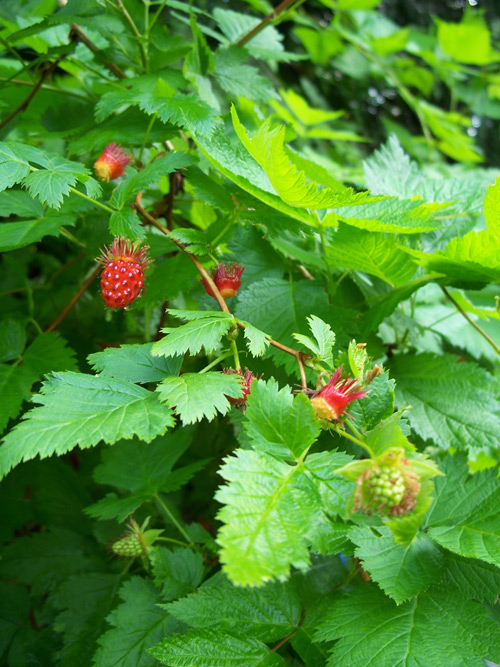Graceful, arching woody stems can grow to 4m tall covered in an abundance of green foliage. The stems are golden-brown with twigs that zig zag here and there. Although hairless they do have scattered prickles. Deciduous deep green leaves are trifoliate with the middle leaflet larger than the 2 side leaflets. The leaf margins are sharp toothed. This time of year the leaves are turning yellow and dropping to the ground.

In early spring the stunning magenta flower of the salmonberry appears. Flowers are star -like with 5 petals and can be 4cm across. Flowers often bloom as early as February bringing vibrant colour to the forest after a dreary winter. Each branch lovingly displays from one to four of these jewel like flowers. Berries replace the flowers and mature in May and June. Yellow to orange in colour resembling red raspberries they are edible appeal to some but not to others. The berries tend to be on the mushy side especially after heavy rains.
Salmonberry thickets provide an important source of food and hiding cover to small mammals and birds. The Rufus Hummingbird is the first to arrive and is attracted to the magenta flowers.[imageeffect type=”lightbox” align=”alignleft” width=”250″ height=”200″ alt=”Salmonberry Flower” url=”/wordpress/wp-content/uploads/2011/12/salmonberry-2.jpg” titleoverlay=”yes”] The leaves are an important spring forage for the black-tail deer and year round sustenance for the elk. The berries are favorites of birds, raccoons, bears, and deer mice. Beaver utilize the woody canes for lodge/dam maintenance. The Swainsons Thrush also known as the “Salmonberry Bird “ sings its beautiful haunting song in late afternoon from the Salmonberry thicket.
First Nations peoples on the coast gathered the young stem sprouts in early spring.They were peeled and eaten raw or steamed as a green vegetable. It was said they had a sweet juicy flavour. The berries were picked and eaten with dried salmon roe or with salmon possibly giving name to this amazing plant. Today the berries and young sprouts are still an important food source. [imageeffect type=”lightbox” width=”250″ height=”188″ align=”alignright” alt=”Salmonberry Bush” url=”/wordpress/wp-content/uploads/2011/12/salmonberry-1.jpg” titleoverlay=”yes”]
The Salmonberry plays an important supporting role in nature and deserves our respect and recognition.
